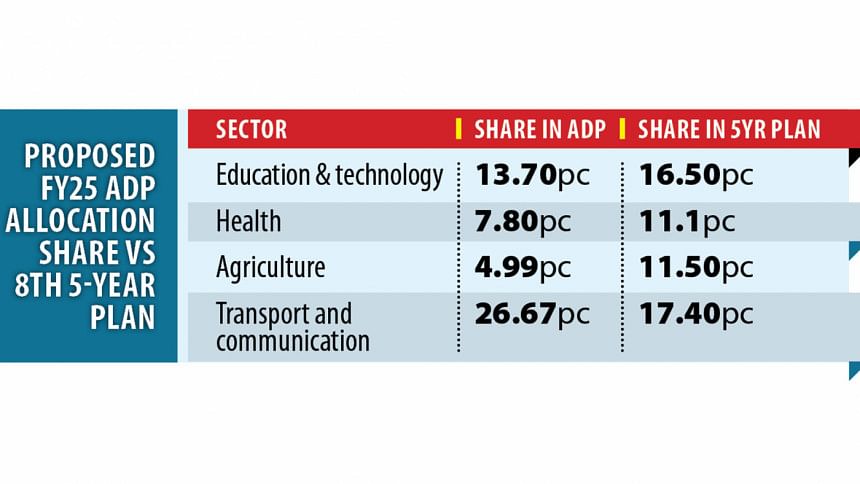Health, education face spending cuts again

Education and health sectors are set to get less Annual Development Plan allocation than prescribed in the eighth five-year plan.
This is a continuation of the downward trend seen over the last four years, even though the two sectors are crucial for a well-educated and healthy population.
According to the draft development budget, which is likely to be placed before the National Economic Council for approval on Thursday, the health sector will get 7.80 percent of the ADP allocation in fiscal year 2024-25. The eighth five-year plan, for fiscal years 2020-21 to 2024-25, prescribed 11.1 percent of the ADP allocation for fiscal year 2024-25.
The education and technology sector is to get 13.70 percent of the ADP allocation, against the plan's proposal of 16.5 percent.
Health and education sectors got similar allocations in the current fiscal year as well.
Planning Commission officials said several sectors, including health, education, agriculture, and social protection, got less allocation in the previous four fiscal years than what was fixed in the five-year plan.
Noted educationist Rasheda K Choudhury said education and healthcare are two of the most vital factors for human development.
"We have been hearing from policymakers that they are putting emphasis on health and education and even the prime minister said so repeatedly. But it is unfortunate that we are not seeing the reflection in the development budget.
"We are implementing many mega projects and developing infrastructure. These play important roles in the country's progress. But if we fail to enhance human capacity, these developments will not be sustainable," said Rasheda, also executive director of Campaign for Popular Education.
If the country cannot properly develop the capacity of its people, it will need to hire experts from abroad, she said, pointing out that the RMG sector alone pays several billion dollars in salaries and allowances to foreign employees. The money eventually goes out of the country as Bangladesh does not have the skilled manpower, she said.
Less allocation for health and education can lead to substandard healthcare and human resource development and it also increases people's out-of-pocket expenditure, said the eighth five-year plan midterm review report placed before the Planning Commission in January.
The low allocation for healthcare is a "historical concern", the report said.
The health sector has been getting allocations less than 1 percent of the GDP against a recommended 3 percent of the GDP, the report said.
Low allocation has serious implications on individuals in Bangladesh, as reflected in high and increasing out-of-pocket expenses, the review said.
It said an out-of-pocket expenditure of 72 percent on healthcare is very high. In India, Bhutan, the Maldives, Nepal, Pakistan, and Sri Lanka, it is much less.
"This is also an indicator of high inequality in healthcare services and a cause of poverty and vulnerability," the review said.
Families bear 71 percent of the total education expenditure in Bangladesh, as per Unesco's Global Education Monitoring Report 2022.
The issue of financing education remains the core of the problem.
In 2023, government expenditure on education was only 1.64 percent of the GDP, whereas most upper middle-income countries spend around 5-6 percent of their GDPs on education, the review said.
If public funding cannot be managed, the government must explore innovative financing mechanisms such as public-private partnerships to mobilise additional resources for the education sector, it said.
Manzoor Ahmed, founder of BRAC University Institute of Educational Development, said the gap between prescription of the five-year plan and actual allocation shows that there is an inconsistency between planning and implementation.
He said education and healthcare should be for all, but only the well-off can afford them.
Planning Commission officials say that education and health ministries get lower allocations as the ministries cannot spend the money. Cost overruns and delays in implementing the projects are also to blame, they say.
The commission's data shows development projects in the health and education sectors had 13 percent and 27.5 percent cost overruns over the last five years.
As much as 55 percent of the health ministry projects and 34 percent of the education ministry projects had to have their deadlines extended.
Rasheda said people should not suffer for management weaknesses. Governance and capacity of implementation of the budget should be improved.
MA Mannan, chairman of the parliamentary standing committee on the planning ministry and a former planning minister, admitted that the allocations for health and education are lower than many other countries and that the budget for them should be increased.
He said budgetary constraints often do not allow greater allocations for these two sectors.
Mannan, however, said vested quarters sometimes do not allow the government to cut allocations elsewhere. "Now it is time to realign the expenditure on health and education."


 For all latest news, follow The Daily Star's Google News channel.
For all latest news, follow The Daily Star's Google News channel. 









Comments